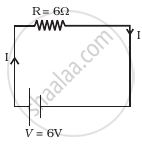Advertisements
Advertisements
Question
Two conductors, made of the same material have equal lengths but different cross-sectional areas A1 and A2 (A1 > A2). They are connected in parallel across a cell. Show that the drift velocities of electrons in two conductors are equal.
Solution
When two wires are connected in parallel the potential difference across the wires will be the same.
V1 = V2 ...............(i)
V1 = Potential across wire A.
V2 = Potential across wire B.
Since two conductors are made up of the same material and have equal lengths, their resistivity will be the same,
`rho_1 = rho_2 = rho`
and `(R_2)/(R_1) = A_1/A_2` ........(ii)
Current (I1) flowing through the conductor with cross-sectional area A1 is given by
`I_1 = A_1n ev_1`
and `I_2 = A_2n ev_2` ..............(iii)
Since two conductors are connected in parallel.
I = I1 + I2
Using Ohm's law,
V = IR
From (i) I1R1 = I2R2
From (iii)
`A_1n ev_1R_1 = A_2n ev_2R_2`
`(A_1v_1)/(A_2v_2) = R_2/R_1`
From (ii)
`A_1/A_2 v_1/v_2 = A_1/A_2`
`v_1 = v_2`
Hence, the drift velocities of electrons in the two conductors are equal.
APPEARS IN
RELATED QUESTIONS
Write its (‘mobility’ of charge carriers) S.I. unit
The number density of free electrons in a copper conductor is 8.5 × 1028 m−3. How long does an electron take to drift from one end of a wire 3.0 m long to its other end? The area of cross-section of the wire is 2.0 × 10−6 m2 and it is carrying a current of 3.0 A.
On the basis of electron drift, derive an expression for resistivity of a conductor in terms of number density of free electrons and relaxation time. On what factors does resistivity of a conductor depend?
When electrons drift in a metal from lower to higher potential, does it mean that all the free electrons of the metal are moving in the same direction?
A conductor of length ‘l’ is connected to a dc source of potential ‘V’. If the length of the conductor is tripled by gradually stretching it, keeping ‘V’ constant, how will (i) drift speed of electrons and (ii) resistance of the conductor be affected? Justify your answer.
When a current is established in a wire, the free electrons drift in the direction opposite to the current. Does the number of free electrons in the wire continuously decrease?
Obtain the expression for the current flowing through a conductor having number density of the electron n, area of cross-section A in terms of the drift velocity vd .
The identical conductors maintained at same temperature are given potential difference in the ratio 1 : 2. Then the ratio of their drift velocities is ______.
- Consider circuit in figure. How much energy is absorbed by electrons from the initial state of no current (ignore thermal motion) to the state of drift velocity?
- Electrons give up energy at the rate of RI2 per second to the thermal energy. What time scale would one associate with energy in problem (a)? n = no of electron/volume = 1029/m3, length of circuit = 10 cm, cross-section = A = (1mm)2

Explain how free electrons in a metal at constant temperature attain an average velocity under the action of an electric field. Hence, obtain an expression for it.
